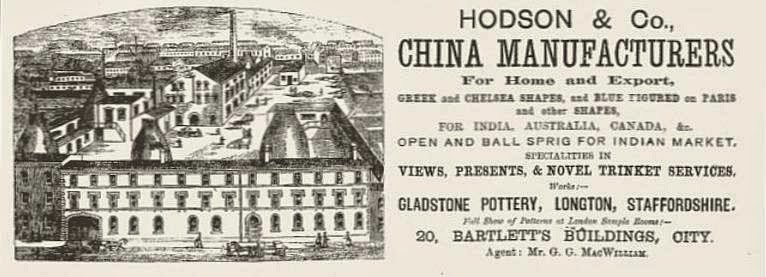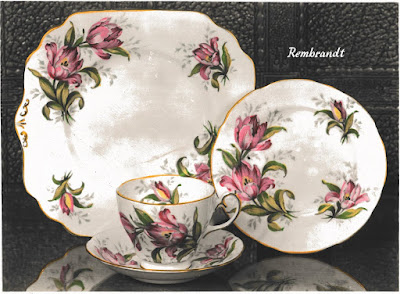 |
| Early image of a view of Gladstone Works Union Hotel on the right. Looking up Uttoxeter Road, Longton Photo: source unknown |
Gladstone before the 1970s
The origin of Gladstone Works dates back to the birth of the pottery industry itself. At the end of the 18th century, Longton was the next largest pottery town after Burslem, and the future growth of Longton was made possible by the sale of the Longton Manor estate in the 1780s.'The history of the Gladstone site is a wonderful example of the history and development of the pottery industry. The complex history of its owners and tenants, and the pottery they produced, is typical of the development of the pottery industry in Longton.'
Click here> for the full history of Gladstone, on the museum's own website
Click here> for Gladstone's Blog on it's history
A history of the Gladstone Site in 200 words
By Rodney HampsonPotteries were developed at Lane End (Longton) with the building of the Newcastle-Under-Lyme to Derby turnpike road in 1759. Thomas and Michael Shelley bought the Gladstone site by the turnpike, in 1774, and by 1787 they supplied cream-ware to "Wedgwood’s standard." They lived on the works, and at their deaths it was divided, leaving only one oven.
By 1840 there were three ovens, and many workshops - a Government Inspector criticising the factory as "dirty, small, dilapidated and unhealthy". In 1856 the present three-story front was built, but continued to be used in part as a house, shops, and even a pub, The Vulcan Arms, until 1914.
Richard Hodson took over in 1869, followed by his son-in-law George Proctor in 1881, and the family, which took up the Gladstone name, installed a steam engine, grinding mills and enamel kilns, keeping control until 1939 when Thomas Poole bought the works, and ran it until 1960.
Gladstone made figures, lustre-ware and, latterly, inexpensive china, the typical Longton product in a typical Longton potbank.
 |
| Gladstone Pottery Museum Story - Hodson and Co. advert 1880 Thanks to Phil Rowley for the image |
 |
| Gladstone Pottery Museum Story - Procter, Mayer & Woolley advert 1885 |
 |
| The Vulcan Arms, Uttoxeter Road, Longton. Just next door to Gladstone Works Photo: source unknown Date: Unknown |
 |
| Gladstone Pottery Museum, Uttoxeter Road, Longton The Vulcan Inn, next door Photo: Rodney Hampson Collection Date: Early 1970s |
 |
| The Vulcan Arms, Uttoxeter Road, Longton. Photo: source unknown Date: Unknown |
 |
| The Vulcan Arms - what was left after its demolition. Became the staff car park for a short while, then filled in and grassed over. Photo: source unknown Date: 1974 |
A HISTORY IN BACKSTAMPS
Gladstone history in backstamps and pots
A study of the backstamps or maker's marks for the Gladstone Works proves interesting. Gladstone has had eight owners since the first pottery factory was built on the site in about 1787. Backstamps began to appear on Gladstone bone china tablewares from 1891, with George Proctor instigating the procedure.George Proctor Co. occupied the site from 1891 to 1939. George himself died in 1910. This company produced china and ‘porcelain' and their backstamp consisted of
G.P.& Co.
L
The 'L' for Longton was occasionally added. The trade name 'GLADSTONE CHINA' was used by the company from 1924 to 1939
From 1940 to 1952 Gladstone China (Longton) Ltd. were the owners. The mark such on wares from 1939 to 1961 incorporated a print of
The factory was shut from 1941 to 1945. No pottery was produced during World War II.
In 1952 Gladstone China (Longton) Ltd. merged with Thomas Poole (Longton) Ltd., who had been producing ‘general ceramics' from 1880. Thomas Poole and Gladstone China were the last active owners of the Gladstone Works - still using the mark adopted in 1940.
 |
| Gladstone Backstamp used in 1953 |
The bottle ovens were last fired in March 1960, as the Clean Air Act of 1956 tightened its grip, but the decorating shop and packing house were still used until May 1970 when when Thomas Poole and Gladstone China closed the factory put the works up for sale.
On 5th November 1971 Thomas Poole and Gladstone China (sometimes known as 'Royal Stafford China' - Thomas Poole had used this name from 1912) merged with the British Anchor Pottery Co.Ltd. who produced earthenware at their potbank by the railway bridge in Anchor Road, Longton. They were owned by the Galley Group of Wolverhampton.
Thus a new company was formed called Hostess Tableware Limited - the name being a name from a previous trade name of British Anchor. The Gladstone, Thomas Poole and British Anchor trade names were dropped.
[In 1973 Hostess Tableware merged with the Clough Group. Interestingly Alfred Clough, was the 'fireman' at the Last Bottle Oven Firing in 1978]
From The Friends of Gladstone Pottery Museum Newsletter October 1977
DATELINE
1921 Gladstone Pottery - works outing to the seaside
 |
| Day Trip Photo: courtesy Gladstone Pottery Museum |
1930 Gladstone from the air
 |
| Gladstone Pottery Museum from the air in 1930 From britainfromabove.org Thanks to Phil Rowley for finding it. |
1930 Bernard and George Procter
The Procter family owned the Gladstone China site from the 1870s, trading as George Procter and Company from 1892.
 |
| The Procters Bernard (Bert) seated and George, his son, in the rather bare and grimy office at Gladstone. Photo: courtesy SOT Museums Collection Date: 1930 |
1939 Ticket to a Party
Gladstone Works Christmas party ticket for "a bit of a do" at Fenton Town Hall
 |
| Gladstone Christmas Party - ticket only - 1939 |
1948 Recollections of working at Gladstone
Random notes made by Rodney Hampson from conversations with ‘Jack’ Bowen of Blurton, 16 March 1980. (Re-typed 3 December 2014 by Rodney Hampson from original manuscript.)Mr Peter Poole was in charge. Employed 200 – china only closed down (during the Second World War) 1939-45 used for storage.
No. 1 oven built c.1950. First firing ‘ran away’ although well soaked!
Two biscuit ovens bottom [of yard?] - two glost at top.
A 'fuss' to celebrate new decorating kiln c.1950 - replaced one kiln in yard by sliphouse (same place as now?).
Saggar maker same place (as now?). He started 1948 - went all electric soon after - ceased endless rope drive – steam heated stoves – flat makers, 3 towers –no mill in 1948 – old packer, Harold – young packer Stan Shaw, went into a crockery (shop)
Evans funeral undertakers in Salisbury. The Vulcan (pub) had a window at rear for beer.
No throwers in 1948 – turners, cup jolliers and handlers - saggar makers on corner.
Gladstone was a friendly place – Thursday was oven day.
Crown Derby sold to Allied English Potteries then old owner set up at Duffield with clay ware from Abbeydale – Lowes (Sutherland Road ?) made Cornish ware blue banded – treadle lathe - pipe of blue slip (below Gladstone, across the road).
Gladstone made tea ware and a little dinner ware – no vases - all china, litho and light gilding, no heavy pattern gold.
1950 Gladstone's Christmas 'do'
 |
| Gladstone Works Christmas 'do' Photo: source unknown Date: 1950s |
1954 Screen shot from a film about the 'Five Towns'
Five Towns Extracts - here> on YouTube |
| Gladstone Pottery Museum from the air - outlined Screen shot courtesy of Phil Rowley |
1955/56 Gladstone Works
 |
| Gladstone Works Corner of Uttoxeter Road and Chadwick St. Photo: John Piper ©The Piper Estate Digital photograph: Photo ©Tate Date: exact date unknown |
 |
| Gladstone Pottery in the distance Looking up Market Street, Longton Photo: source unknown Date: 1955 |
 |
| Gladstone Works - flatware makers 1955-6 Photo courtesy of Phil Rowley, but who are these people? |
 |
| Gladstone Works warehouse (Now Gladstone Pottery Museum café ) Photo: courtesy Gladstone Museum Date: 1950s |
1970 Gladstone Works staff
"This is a presentation to Miss Hilda Botham on her retirement as decorating manager at Thomas Poole and Gladstone China (Royal Stafford China), Cooke Street, Longton. [about 1970] The presentation was made by Managing Director Ken Allerton of British Anchor Pottery. In 1970 The Gailey Group gained control of Thomas Poole and Gladstone China and merged with British Anchor Pottery into their new acquisition to become Hostess Tableware Ltd., a British Anchor trade name since the 1960's. Ken Allerton's family were Charles Allerton & Sons (1859-1942) also Vincent Collingwood Sales Director Thos Poole, his family owned Collingwood China Ltd." Text and photo courtesy of Kath Roberts, April 2020 |
| Retirement of Miss Hilda Botham Decorating Manager Thomas Poole and Gladstone China Photo: courtesy of Kath Roberts Date: 1970 |
May 1970 Gladstone Works is put up for sale
Hostess Tableware, owners of Gladstone Works, decide to sell the entire site for the sum of £12,000. According to measuringworth.com the relative value of this in 2018, using the percentage increase in the Retail Price Index, was £173,000.25th March 1971
Gladstone Works saved from the wrecking ball by an anonymous pledge of just £12,000 to buy the entire site.
The Gladstone Works yard. Notice the concrete in the yard, the weighbridge, weighbridge cabin and the mirror above the tunnel, used by the fireman to check the emissions from the boiler house chimney without leaving the building.
.
Early 1970s Gladstone buildings
| The rear of Gladstone Works c1970 Photo by Sid Meir, courtesy Ian Mood |
 |
| The rear of Gladstone Works c1970 Photo by Sid Meir, courtesy Ian Mood |
 |
| The rear of Gladstone Works. Rosslyn Works c1970 Photo by Sid Meir, courtesy Ian Mood |
 |
| The rear of Gladstone Works c1970 Photo by Sid Meir, courtesy Ian Mood |
 |
| Gladstone Works - the yard Photo found by Phil Rowley Date: Late 1960s/Early1970s |
1971 Gladstone China
 |
| Gladstone China pre museum Photo taken from outside the works on land which is now the current car park Photo: source unknown Date: 1971 |
1972 Gladstone China, pre museum
 |
| Gladstone China 1972 pre museum Photo: source unknown Date: unknown |
 |
| Gladstone China pre museum Photo: source unknown Date: 1970 |
 |
| Gladstone China, pre museum Photo: source unknown Date: 1972 |












